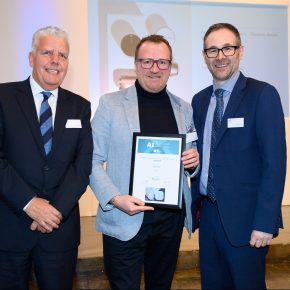
Solving key challenges in education sector security – ASSA ABLOY
Filtering access into and through any education institution is a formidable task. Diverse user groups have contrasting needs, from senior management teams to cleaners, IT staff to students, as ASSA ABLOY explore here.
Indoor and outdoor spaces may require totally different levels of security. Visitors should experience a controlled, curated flow through the site.
Staff need timely access to teaching rooms. Student access to the library or IT suite must be monitored. All this must be achieved while maintaining exactly the right degree of openness and welcome.
Budgeting is an ever-present challenge. Although a familiar technology, physical keys require security management which can be time-consuming and labour-intensive.
Physical key admin puts added pressure on busy staff when someone loses a key, for example. Locks need changing; keys recut and reissued — and this costs money.
With an electronic access system instead of traditional lock-and-key security, a few clicks in the management software cancels and reissues all relevant credentials, with almost no extra cost added. It saves facility managers’ valuable time and the organization’s money.
Wireless locking is fast and cost-effective to install, because it requires no invasive drilling. It’s also cheaper to run as, unlike wired locks, wireless door devices are powered by batteries and use very little energy.
Education institutions all over the world have already found success by switching from mechanical to wireless electronic access control, in both cost and time savings, and by addressing challenges specific to their sector and situation.
Schools: time-saving access control without a specialist security team
Small establishments such as local schools do not have the budget or need for an in-house security expert. Yet their security challenges match any faced by large institutions. An access control technology suited to schools must be intuitive to operate — both hardware and software.
Maintenance presents another problem: in-house staff are unlikely to have the expertise, yet contracting a specialist is expensive.
At Vejle Friskole in Denmark, managing security based on physical keys had been eating up ‘a very long time, approximately 5 hours a week’, according to Henrik Kækel, the school’s Technical Service Officer.
Vejle Friskole’s mechanical keys have since been replaced by an access control system; around 80 doors and cabinets are secured with SMARTair wireless locks.
Approximately 250 students and teachers carry their own fob, programmed with individual access permissions. Locking devices fit many different types of opening, so everyone at the Friskole opens doors and cabinets with a single fob. There’s no need for separate locker keys, for example.
Wireless devices secure offices and classrooms, and are robust enough to handle high traffic at the main entrance door. Everything is managed efficiently with the SMARTair software.
Henrik added: “It was really bad [before] because we had big problems with keys that were lost. There was a lot of work in key administration.”
Today, Vejle Friskole staff spend around 5 minutes a week managing their access system. They also have the option to extend their access control system whenever they want to gain even more granular control over school buildings.
Fast to install, SMARTair locking devices are an ideal, cost-effective retrofit solution for the education sector.
Universities: attracting international students with modern security
Prospective students weigh up campus safety when choosing a university*. This may be especially true in the lucrative, competitive market for international students — for whom anxious parents needing reassurance are also key decision-makers**.
Students enjoy tech-based solutions to everyday problems — security and access control included. In Mexico, Arkansas State University Campus Querétaro (ASUCQ) uses a mobile solution instead of keys or key-cards to unlock doors.
The smartphone communicates with lock readers via standard mobile protocols, exactly as an access card would. There is no difference in the locking hardware, only the credential.
With a SMARTair Openow mobile system, staff and students keep ‘virtual keys’ inside an app. Campus managers can amend every virtual key’s access rights whenever they want, in real time if necessary: ASUCQ’s system is online.
A smartphone-based solution is perfect for a user-group — students — who lose credentials with ease. “It’s much easier to lose a card than a mobile phone,” says José Alfonso Suárez, ASUCQ’s Head of Operations***.
On-device password and fingerprint ID add another layer of credential protection. Such modern security doubles as a marketing tool, signalling the university’s commitment to student safety: it has an ROI beyond keeping the campus safe.
Student accommodation: an easy solution to the lost key problem
Keys are easy to lose. Students can be prone to misplacing things. It is a tough combination for anyone running student accommodation.
For new premises in Rennes, France, specialist provider Easy Student sought reliable, key-free locking. They wanted the residence to run efficiently — ‘like a hotel’ — and without the workload of physical keys. Switching to wireless electronic locking managed via simple software is a huge time-saver for these student halls.
Easy Student also chose SMARTair access control****. Cyril Verger, Managing Director at Easy Student Rennes, commented: “SMARTair does not require any technical knowledge. I trained quickly and found the software very easy. The solution really simplified my life.”
If someone loses a credential, the software interface makes cancelling it fast and easy — a major change from the old days of mechanical locks and key organization charts. Cyril added: “A lost key can still be used. A lost credential can be cancelled easily.”
Every Easy Student credential is programmed to open multiple doors: the student’s own room, the main door and bike park around the clock; plus the common area and laundry room between 6.30am and 11.30pm only.
Cyril continued: “Our students are very happy with the solution. They got used to it quickly, because this type of access control is found in lots of hotels and private homes.
For more on the benefits of SMARTair® wireless electronic access control, you can download a free Solution Guide
Sources
*: www.thecompleteuniversityguide.co.uk/student-advice/where-to-study/crime-rates-in-university-cities-and-
towns
**: see https://eric.ed.gov/?id=EJ1180979
***: https://youtu.be/l-M7SMUEd9E
****: watch the video case study at https://youtu.be/nTHdpH2haQo
Contact ASSA ABLOY Opening Solutions EMEA Digital and Access Solutions
Dukes Court/Dukes Street
Woking
GU21 5BH
United Kingdom
Web: About us | ASSA ABLOY
Email: [email protected]
Phone: 0049 30 8106 2970
Visit Supplier's page
Latest news

23rd April 2024
Trio of Senior products used in new Nottingham residential scheme
Solutions from Senior Architectural Systems have helped complete The Barnum – a new residential development on Nottingham’s Queen’s Road.
Posted in Aluminium Products, Articles, Building Industry News, Building Products & Structures, Building Systems, Case Studies, Curtain Walling, Doors, Glass, Glazing, Posts, Restoration & Refurbishment, Retrofit & Renovation, Walls, Windows
22nd April 2024
New EJOT role will develop strategic support for UK flat roofing sector
EJOT UK has taken a major step in the expansion of its support for the flat roofing market by appointing one of its most experienced building envelope fastening specialists as its first sector-dedicated business development manager.
Posted in Articles, Building Industry News, Building Products & Structures, Building Systems, Innovations & New Products, Posts, Recruitment, Restoration & Refurbishment, Retrofit & Renovation, Roofs
22nd April 2024
Access2 Wins ADSA-Sponsored Award at AI Specification Awards
Access2 clinched the ADSA-sponsored Product Design and Innovation Award (Electronic) at the AI Specification Awards 2024 on Thursday.
Posted in Access Control & Door Entry Systems, Architectural Ironmongery, Articles, Awards, Building Associations & Institutes, Building Industry Events, Building Industry News, Building Products & Structures, Building Services, Doors, Facility Management & Building Services, Information Technology, Innovations & New Products, Retrofit & Renovation, Security and Fire Protection, Video of the Week
19th April 2024
ASSA ABLOY: Access solutions can impact sustainability performance across the full life-cycle of a building
Embedding sustainability within any organisation requires a broad, strategic perspective. Scrutiny should include the physical infrastructure itself: According to the IEA, buildings consume around 30% of global energy*. ASSA ABLOY has more…
Posted in Access Control & Door Entry Systems, Architectural Ironmongery, Articles, Building Industry News, Building Products & Structures, Building Regulations & Accreditations, Building Services, Case Studies, Doors, Facility Management & Building Services, Information Technology, Research & Materials Testing, Retrofit & Renovation, Security and Fire Protection, Sustainability & Energy Efficiency, Video of the Week
 Sign up:
Sign up: